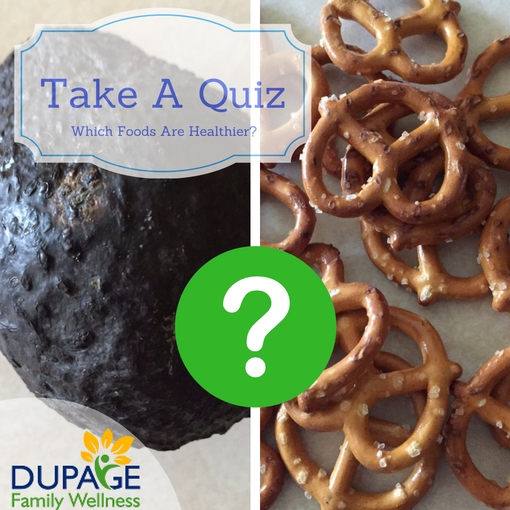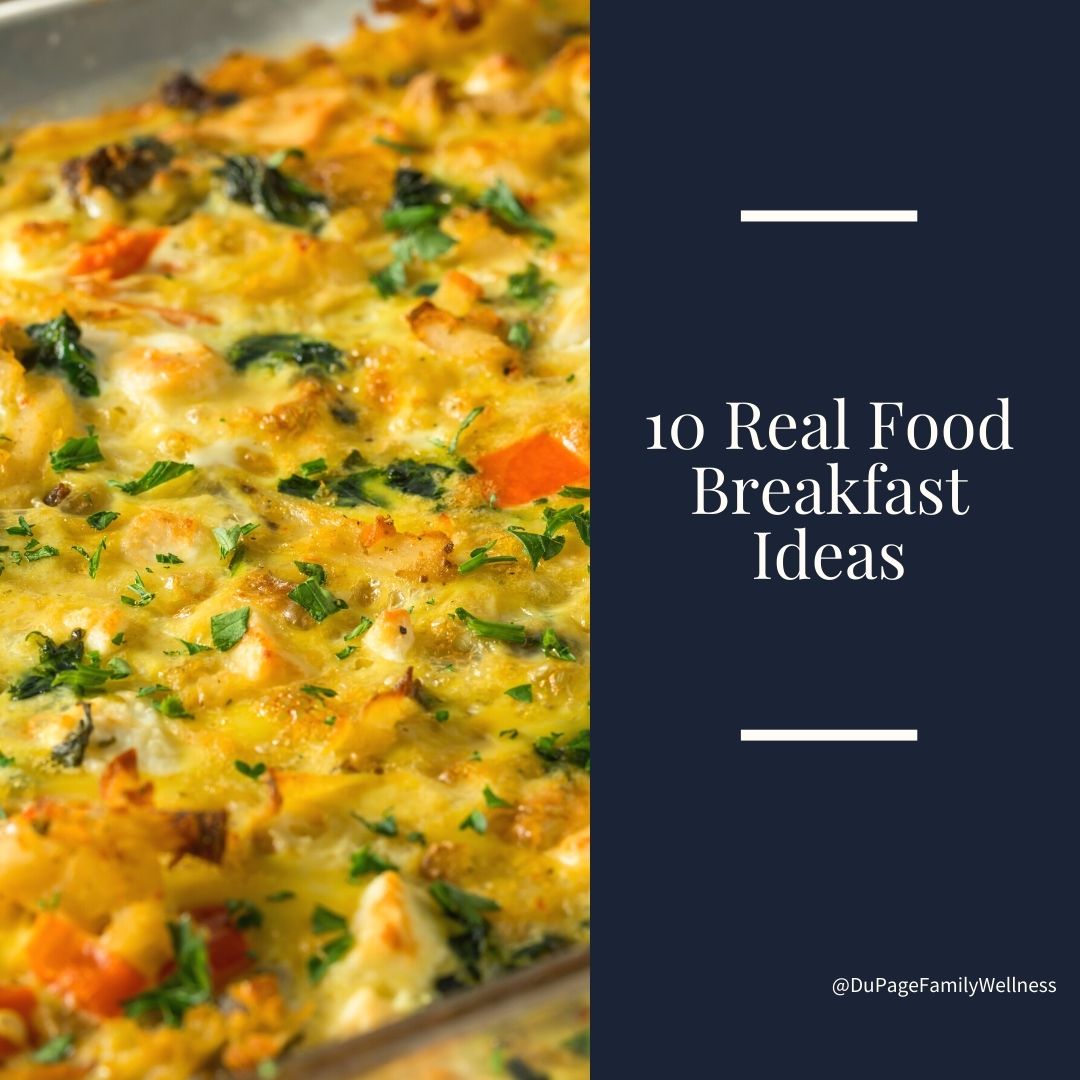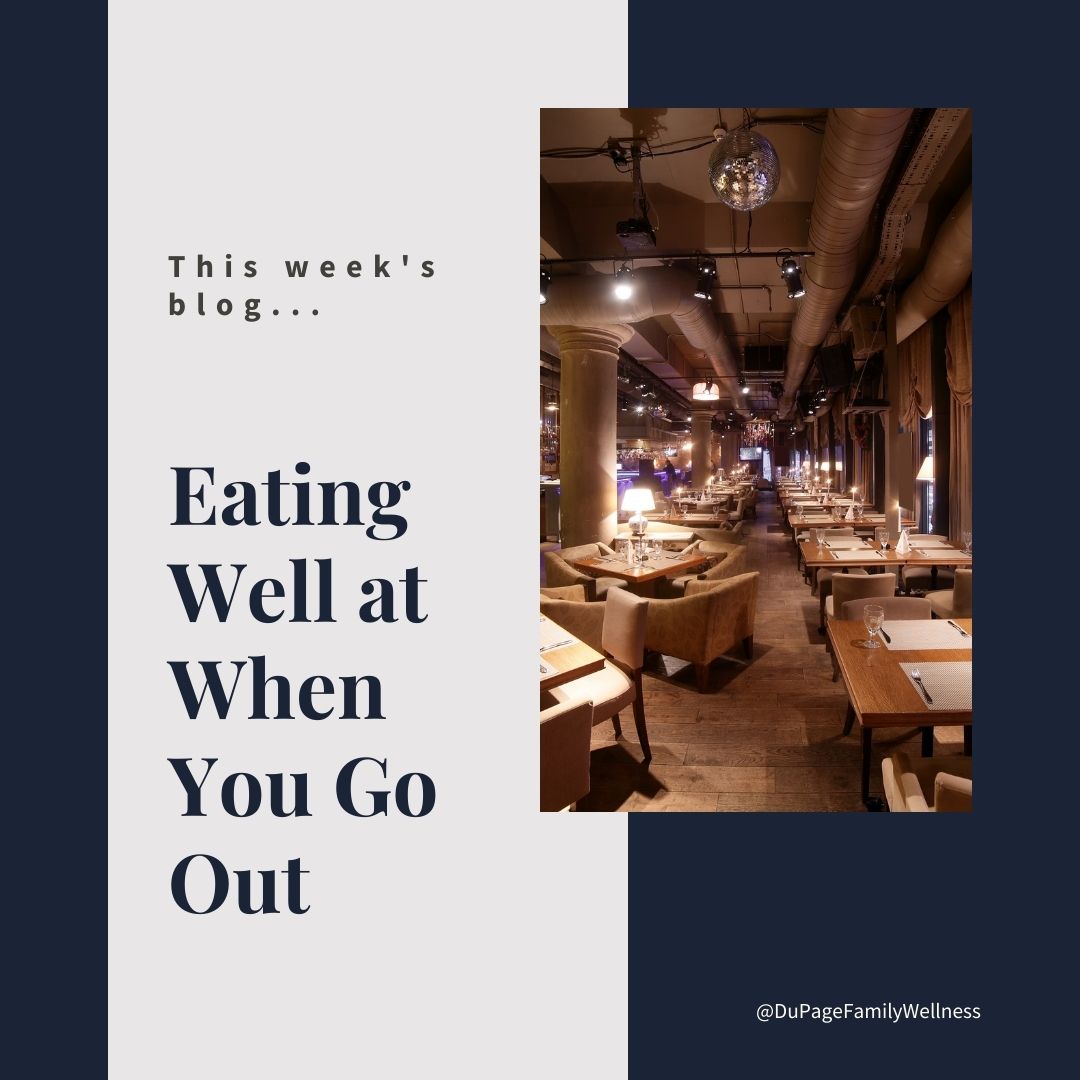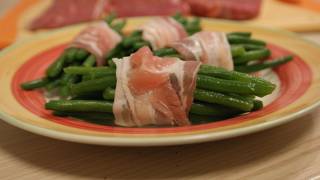
Take a Quiz- Which Do You Think is Healthier?
- Eggs OR Egg whites?
- Butter OR Margarine?
- Pretzels OR an avocado?
- Grass fed beef burger OR vegetarian meatless soy burger?
- Oatmeal OR a veggie omelet?
- 100 Calorie Snack Pack OR an Apple with Almond butter?
My Answers Have Changed Over Time!
If you had asked me a few years ago and again today, I would have given you completely different answers. Over the years I have done quite a bit of research into nutrition, and as I have learned more my opinions have evolved. Here are my answers today. Keep reading to learn what changed my opinion, and how this has improved my life. I've seen the same improvements in the lives of my patients.
Answers Now:
- Eggs- There are beneficial nutrients in the egg yolk, that you would miss out on if you just eat the egg white.
- Butter- Butter has a few very simple ingredients while margarine is highly processed and is full of damaged and denatured fatty acids including trans-fats that are harmful to our bodies.
- Avocado- I have learned how important it is to eat healthy fats and avocado is a great source. Pretzels on the other hand have long ingredient lists and almost no nutrients.
- Grass Fed Beef- Meat from a good healthy source is a great source of protein and omega 3 fatty acids. Processed meatless products, on the other hand, consist of a long list of highly processed ingredients. Soy itself makes people produce more estrogen that can throw off their hormone balance.
- Omelet- Eggs and veggies offer more beneficial nutrients than oats! They are also a good balance of fat, protein, and carbohydrate while oatmeal is pretty much purely carbohydrates.
- Apple with Almond Butter- While this might have more calories than the snack pack, it offers more nutrients (vitamins and minerals) and less artificial processed ingredients.
What is the difference? I care about eating good nutrients, and no longer worry about how many calories I eat.
Conventional Wisdom - What I Used to Think
About 8-9 years ago, I kept track of every single bite that I ate. I measured foods and counted every last calorie. I knew how many calories I was supposed to eat for my weight and activity level. I thought that if I burned more calories than I consumed, then I should lose those dreaded 10 pounds. I knew that the caloric value of a pound was 3500 calories, so if I kept a 500 calorie deficit every day, I should lose 1 pound/week. There were two problems.
- It was tedious and hard to track.
- More important, it did not work as expected! Even when the equation was tipped toward losing weight, the weight did not come off!
I could never understand why the simple calories in / calories out equation did not give me the results I expected. I also avoided fat (because it has lots of calories), and thought that eating too much fat would make me gain even more weight.
A Revelation - What I Learned
About 4 years ago, I went to a nutrition seminar series that TOTALLY changed my way of thinking. I learned that our bodies are MUCH more complex than a simple calories in / calories out equation to be balanced. The body is an amazing and complex system and food is used for much more than energy. What we eat causes HORMONAL CHANGES that impact whether we are in storage mode, or fat burning mode. Eating the right foods allows our bodies to function at its best and heal itself as needed. Eating the wrong foods causes other inflammatory reactions in the gut that can wreak havoc on our whole bodies. These inflammatory reactions cause everything from acid reflux to acne to heart disease and diabetes.
For example, let's look at how the body processes carbohydrates. Eating processed carbohydrates (breads, pastas, pretzels, tortillas, cookies, cake, crackers, chips, granola bars, etc.) spikes blood sugar. The body attempts to reduce it's blood sugar back to normal by releasing a hormone called insulin. This triggers the body to store the extra glucose (sugar) in fat cells. Since I ate these carbohydrates at every meal- and even as snacks between meals, I was constantly spiking my blood sugar, releasing insulin, and storing the extra glucose in my fat stores. While I thought I was eating a good low calorie diet, what I was really doing was starving my body of key nutrients (due to my lack of vegetable eating), and staying in fat storage mode. No wonder I had a hard time losing weight- I was eating too many carbohydrates to get my body into fat burning mode and use my body's fat stores as fuel.
What I eat now (and you should too!):
REAL FOOD! Foods that humans have been eating for thousands and thousands of years. Foods that our bodies have grown accustomed to processing. Nothing that was made in a factory (yes that means bread and pasta- even the whole grain kind). Nothing that has big long ingredient names you can’t pronounce. Nothing that was genetically modified (we’ll talk more about this a different day, but it’s way more common than you might think!)
- Vegetables- I eat as many as I want and am hungry for! No need to count anything. Ideally, they come from a local farmer and are in season. I try for at least 6 servings, 2 at each meal, sometimes more!
- Meat- Best from HEALTHY animals that got to eat their natural diets and walk (or swim) around while they were alive. I have some everyday- it is important for getting certain vitamins like B12. I try to get my meat by the whole animal and even eat the organ meat (containing so many good nutrients) and use the bones to make broth!
- Fruits- I eat 1-2 servings/day. I look for locally grown in season fruit when possible.
- Healthy fats- Like coconut oil, Real Butter (from healthy grass fed cows), animal fats, avocados, some nuts. Fats are a vitally important energy source. There are some fatty acids (like Omega 3s) that our bodies can’t make, so we HAVE to eat them. Eating fat does not make you fat!
Foods that I used to consider healthy that I avoid now: Fat free yogurt, skim milk, granola bars, pretzels, whole wheat pasta, whole grain bread, oatmeal, and processed soy/vegetarian substitutes.
The great thing about REAL FOODS is that there isn't a group of scientists trying to make the perfect combination of fat, sugar, salt and chemicals to make them addictive (the very reason it is hard to eat just one potato chip or oreo!). Mother nature doesn't use cheaper ingredients to improve the bottom line, or add chemicals to lengthen the shelf life. Real food is what it is. Eat as many vegetables as you want. If you eat more, you get more nutrients. You will stop because the natural fiber will make you feel full.
How These Changes Have Improved My Life:
• Lost Weight
During my senior year of college, when I was most serious about calorie counting, my weight was 172. My current weight is 160. The extra 10 pounds I was so worried about melted right off, and stayed off, when I gave my body better, "real food" ingredients to work with!
• Acne and Allergies Cleared Up
Before I also mentioned that eating processed foods leads to inflammation in our bodies. I suffered from seasonal allergies and acne as long as I can remember. I had no idea that both conditions were inflammatory in nature. Since I changed my diet. I have seen huge improvements in my skin and my seasonal allergies. I wish I would have known years ago that eating these whole unprocessed foods would help my skin to become clearer and reduce my seasonal allergy symptoms.
Obviously, in our fast paced society it can be hard to avoid all processed "food", The first step to becoming healthier is to understand what is healthy and why. As you learn more, you think about how food (or food like products) affects your body. It is not the CALORIES that are important, it is the NUTRIENTS.
Shoot me an email or chat with me on my facebook page to let me know how you did on the quiz, and if you learned anything from reading my story!
Dr. Jamie Thomure
 Once you decide to eat real, unprocessed foods, breakfast can be a roadblock. Most people are pressed for time in the morning but still want a quick and easy, yet satisfying breakfast. In light of this, people routinely turn to milk and cereal as a quick option. Keep reading for some better ideas.
Once you decide to eat real, unprocessed foods, breakfast can be a roadblock. Most people are pressed for time in the morning but still want a quick and easy, yet satisfying breakfast. In light of this, people routinely turn to milk and cereal as a quick option. Keep reading for some better ideas.
What’s wrong with cereal and milk?
There are 2 big reasons to avoid the standard milk and cereal breakfast.
- Cereal is not a "real food". Read the ingredient label on any cereal box, even the whole grain and organic varieties. The list usually includes some form of added sugar, along with 20-30 ingredients, many of which you cannot pronounce.
- Cereal is primarily carbohydrates, which your body converts to glucose (sugar). This is a quick burning source of fuel that gives you a surge of energy, but it only lasts for a couple of hours and then you are starving and tired again. You might find yourself heading to the break room for more coffee and a pastry. To avoid that crash, breakfast should include long-burning fuel sources provided by proteins and fats. This will keep you satisfied until lunch.
What About Oatmeal?
Steel cut or old-fashioned oatmeal passes the "real food" test, but it is a "filler" like rice or potatoes, that contains mostly carbohydrates (56 grams in a cup), and not many other nutrients. Although oatmeal is better than processed cereal, you may find that it does not have the fat and protein to keep you satisfied all morning. Read more about the pros and cons of oats.
The flavored oatmeal that comes pre-packaged in single servings is NOT real food. It contains many artificial ingredients, and added sugars just like other pre-processed cereals.
What About Eggs?
Traditionally, the recommendation has been to avoid eggs to keep your cholesterol down. Eggs have gotten a bad rap, but that is being reversed by current research. See Dr. Thomure's explanation of why you do not need to fear eggs.
Top 10 real food breakfast ideas:
10) Leftovers from the night before. While unconventional having soup or leftover meat & vegetables for breakfast is a good way to start the day.
9) Two-ingredient Banana and Egg Pancakes. (A quicker method that makes a custard-like concoction is to microwave the same ingredients. Mix the 2 eggs and 1 banana in a microwave-safe bowl. Cook for 1 minute on high power. Stir, mixing the cooked edges into the mixture. Cook for 2 additional minutes on power 5. Serve with butter and top with blueberries or strawberries. Yum!)
8) Ham and Egg Breakfast Cups - a super simple and delicious breakfast idea.
7) Breakfast Smoothie
6) Breakfast Skillet topped with an egg. (My favorite combo is sweet potato, spinach, onions, and a granny smith apple.) When the skillet is almost cooked, break one or more eggs on top and cover as it finishes cooking.
5) Full fat, PLAIN yogurt topped with fruit and nuts. You can even make easily make your own yogurt!
4) Avocado Egg Cups - a great way to incorporate healthy fats to keep you going all morning
3) My favorite Banana Bread or Muffins. Top with butter or nut butter to make it more filling.
2) Homemade Energy Bars - Make ahead for a grab-and-go breakfast.
1) Egg Casserole. This is our standard breakfast. I make it at the beginning of the week. I love it because it’s quick to reheat and an easy way to get eggs and veggies in the morning!
What are your favorite real food breakfasts?
Joelle Kurczodyna, NTP
 Our newest little Illini Fans!After a much needed break and two babies later – we are back! If you’ve followed the DuPage Family Wellness blog, you know that we are passionate about eating real food. However, over the last several weeks of welcoming newborns into our homes, we have seen firsthand how difficult it can be to actually shop and prepare real food for your family. We’ve found that planning ahead and being organized are crucial to getting a real food meal on the table and not succumbing to the ease of convenience, processed, and fast foods.
Our newest little Illini Fans!After a much needed break and two babies later – we are back! If you’ve followed the DuPage Family Wellness blog, you know that we are passionate about eating real food. However, over the last several weeks of welcoming newborns into our homes, we have seen firsthand how difficult it can be to actually shop and prepare real food for your family. We’ve found that planning ahead and being organized are crucial to getting a real food meal on the table and not succumbing to the ease of convenience, processed, and fast foods.
If you are trying to be healthier and interested in removing processed foods from your diet and incorporating more real foods or if you are a seasoned veteran, there are several, simple things that we have found to make eating real food possible in the midst of the busyness of life. In light of that reality, we will be posting “real food weekly challenges” over the next several weeks. These will be basic weekly cooking challenges that you can do to help make your life easier and provide real food for your family for that week. Overtime, by implementing a few of these things every week, you will find that preparing real food meals for your family will be much more doable and hopefully even enjoyable. We may also throw in some movement challenges to help incorporate more movement in your day. Time after time, we have seen how the combination of eating real, unprocessed food and moving the body have allowed people (including ourselves!) to reach their health goals! We are excited for you to do these challenges along with us and see what happens!
Along with posting these regular food challenges, we will also be offering another 5 week long RESTART® class to help you kick those sugar cravings and look and feel your best as we head into spring. The next class will begin on Wednesday April 6th from 7-8:30 the Warrenville Office and continue for 5 weeks on Wednesday nights with the last class being May 4th. Learn more here and email This email address is being protected from spambots. You need JavaScript enabled to view it. with questions!
Also, Dr. Thomure is back in the office seeing patients with the following hours:
Monday: 2:00 – 6:00
Wednesday: 2:00 – 6:00
Friday: 10:00 – 1:00
Call our office at 630-448-0255, or email (This email address is being protected from spambots. You need JavaScript enabled to view it.) to schedule.
 Eating out can be very tough! You don't always know how your food is being prepared. It seems like 90% of the options come with some sort of bread/tortilla/French fry, etc. Sauces are almost always thickened with flour or corn starch. One of my favorite ways to keep things in check is to sub out items on the menu for healthier options!! While this isn't always possible, you never know if you don't ask!
Eating out can be very tough! You don't always know how your food is being prepared. It seems like 90% of the options come with some sort of bread/tortilla/French fry, etc. Sauces are almost always thickened with flour or corn starch. One of my favorite ways to keep things in check is to sub out items on the menu for healthier options!! While this isn't always possible, you never know if you don't ask!
Top 5 restaurant substitutions I have managed to get- just by asking!
- Veggies instead of Tortilla Chips at a Mexican restaurant (Changarro in West Chicago did this for me!) I didn't think they'd do this for me, but I asked if there was something else besides chips to dip in the delicious salsa, and they brought me some veggies!
- Veggies instead of fries (occasionally there will be a small up charge, but well worth it!)
- A Stir Fry with extra vegetables instead of rice or noodles
- A lettuce wrap or bed of greens instead of a bun or bread. This could be with a burger, chicken, fish, heck I've even eaten an "italian beef salad"
- Oil and Vinegar instead of other salad dressing. This one I recommend because salad dressings are notorious for having all sorts of weird added ingredients and sugar. My best bet if I'm eating out is always Oil and Vinegar, because at least that way I have a better idea of what I'm eating. Sometimes if there are enough delicious ingredients in the salad, I just leave off the dressing all together.
If you are being very strict or have food allergies, you can ask your waiter about what types of oils they use for cooking and where the meat/produce came from. Depending on the restaurant, they may or may not know the answers to those questions.
If there is an option of cooking oil, my top choice would be coconut oil, or a form of animal fat (butter, lard, duckfat, etc) They have more saturated fats, and can go to high temperatures better. I would stay away from highly processed cooking oils like vegetable oil, canola oil, etc. Here is a guide for which fats to cook with, which to eat raw, and which to avoid all together!
Since I don't go out to eat very often, I typically just try to do the best I can, knowing that it is a treat, and I can't control everything about the way my food is prepared all the time.
Dr. Jamie
Need more motivation to begin eating real food and get healthy? This is what one of the participants from the last class had to say about her experience!
With Restart, I have lost almost 13 pounds. I really don't miss all the sugary foods that I was eating. I can't believe how much I enjoy eating my salads and veggies. I took away from this program, how important it is to forgive yourself if you do eat something, not on the program. Eat it, enjoy it and move on. I am motivated to stick with this way of eating since the program. Yes, Bacon is allowed on RESTART! Eating Real Food can taste so good and we will give you some great tips and recipes!
Yes, Bacon is allowed on RESTART! Eating Real Food can taste so good and we will give you some great tips and recipes!
This 5 week program to RESTART® your health begins this Monday from 7-8:30.
What is The RESTART® Program?
RESTART® is a 5-week program with a 3-week sugar detox built into it. Part nutritional class, part sugar detox, and part support group, it is a powerful and empowering combination for success!
Are You Ready?
Just like this recent RESTART® participant, you too will experience the side effects of the The RESTART® Program, which include (but are not limited to):
- Weight loss
- Better sleep
- More energy
- Boosted Immunity
- Reduced cravings for sugar and starchy carbs
- Mental clarity, calmness and even temperament
- Reduced PMS and menopausal symptoms
- An appreciation for the taste of REAL FOOD!
Click HERE to learn more or sign up!
"I never thought I could do this, but with all the information and support, it went by really fast and I feel great! You have changed my life and I thank you for that!"
"Since I did The RESTART® Program I'm off of two medications; one for asthma and the other for acid reflux. I can't tell you how excited I am about this!"
I can't tell you how excited I am about this!"
These are just a few things people are saying about the RESTART® Program.
What is The RESTART® Program?
RESTART® is a 5-week program with a 3-week sugar detox built into it. Part nutritional class, part sugar detox, and part support group, it is a powerful and empowering combination for success!
Are You Ready?
Side effects of the The RESTART® Program may include (but are not limited to):
- Weight loss
- Better sleep
- More energy
- Boosted Immunity
- Reduced cravings for sugar and starchy carbs
- Mental clarity, calmness and even temperament
- Reduced PMS and menopausal symptoms
- An appreciation for the taste of REAL FOOD!
You will also learn:
- How to prepare mentally, physically, and emotionally to make successful changes to your diet.
- How Digestion is supposed to work and simple ways to enhance yours.
- What sugar really does in your body, the stages of dysglycemia (Hypoglycemia, Hyperglycemia, Insulin Resistance, Type 2 Diabetes), and effective ways to reduce your risk of these conditions.
- The truth about FATS and why healthy fats are essential for healthy Blood Sugar Regulation, as well as your general good health. You will learn which fats to eat, which fats to avoid, and why!
- How to move forward from the sugar detox and re-introduce foods in a healthful way back into your daily diet.
The next 5-week class begins Monday, October 26th from 7-8:30! Click HERE to learn more and sign up. Want to take RESTART® but can't do Monday nights? Email This email address is being protected from spambots. You need JavaScript enabled to view it. today as more class times are pending.



 Once you decide to eat real, unprocessed foods, breakfast can be a roadblock. Most people are pressed for time in the morning but still want a quick and easy, yet satisfying breakfast. In light of this, people routinely turn to milk and cereal as a quick option. Keep reading for some better ideas.
Once you decide to eat real, unprocessed foods, breakfast can be a roadblock. Most people are pressed for time in the morning but still want a quick and easy, yet satisfying breakfast. In light of this, people routinely turn to milk and cereal as a quick option. Keep reading for some better ideas.
 Eating out can be very tough! You don't always know how your food is being prepared. It seems like 90% of the options come with some sort of bread/tortilla/French fry, etc. Sauces are almost always thickened with flour or corn starch. One of my favorite ways to keep things in check is to sub out items on the menu for healthier options!! While this isn't always possible, you never know if you don't ask!
Eating out can be very tough! You don't always know how your food is being prepared. It seems like 90% of the options come with some sort of bread/tortilla/French fry, etc. Sauces are almost always thickened with flour or corn starch. One of my favorite ways to keep things in check is to sub out items on the menu for healthier options!! While this isn't always possible, you never know if you don't ask!

